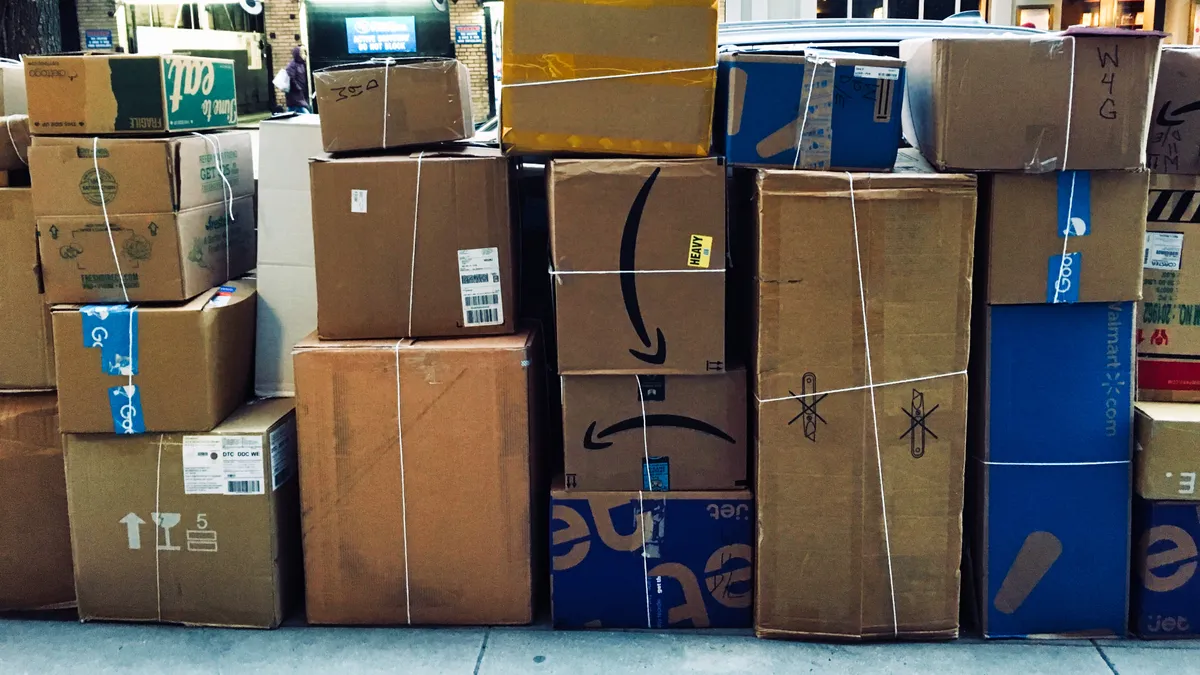Dive Brief:
- E-commerce sites boosted their advertising spending as the COVID-19 pandemic drove a significant shift in U.S. shopping habits. Ad spend from e-commerce sites doubled from $4.8 million for a trailing four-week period starting on Feb. 17 to $9.6 million for the week of March 9, per information that analytics firm MediaRadar shared with Marketing Dive.
- The firm conducted the study after Amazon, which has an estimated 38% share of the U.S. e-commerce market, announced last week that it plans to hire 100,000 more warehouse and delivery workers. The company is expanding headcount to keep up with demand for online shopping as consumers are forced to stay home because of the coronavirus.
- “Amazon is fully aware that many Americans will be spending much more of their disposable income online in the coming weeks," Todd Krizelman, co-founder and CEO of MediaRadar, said in a statement. "According to our data, it’s clear that the rest of the e-commerce market knows it, too.”
Dive Insight:
E-commerce sites like Amazon have had to adjust quickly to a sudden change in shopper behavior as many people work from home, shop online to avoid going out in public or to seek goods that have been in short supply at stores. Online shopping has provided a key lifeline for millions of consumers to the outside world. The higher ad spending among e-commerce companies, as observed by MediaRadar, reflects their efforts to stand out as more consumers shop online, putting strains on distribution systems at e-commerce companies and grocery chains that have expanded pickup and delivery.
While e-commerce sites are boosting their online ad spending in the short term, the negative economic repercussions of the coronavirus are expected to dampen media spending worldwide. Instead of growing 7.4% to $712 billion in 2020, total media spending is predicted to expand 7% to $691.7 billion this year, eMarketer said in a revised forecast. The researcher attributed the slower growth to the effects of coronavirus on China, although it also cautioned that its estimate was completed on March 6, before President Donald Trump announced a 30-day ban on most travel from Europe.
Online shopping for necessities has been especially popular among Generation Z and millennials amid growing concerns about the coronavirus, which the World Health Organization designated as a pandemic on March 11. Fifty-eight percent of people ages 18 to 39 said they had ordered grocery items online for store pickup, and 30% said they had increased their online purchases in the month leading up to March 12, per a survey by marketing firm Acosta. That compares with 34% of general population that ordered grocery items for store pickup, and 25% who had increased purchases, the study found.
The coronavirus crisis has led consumers to stock up on cleaning products and other necessities. Thirty percent of shoppers said they had bought hand sanitizer, making it a bigger priority than disinfecting wipes (28%), household cleaners (25%), antibacterial hand soap (24%), paper products (24%), bottled water (22%) and canned foods (20%). With the shift in consumer purchase behaviors, Acosta recommends that retailers consider limits for the most demanded preventative and pantry-loading products, while manufacturers of those products consider delaying promotions to avoid greater depletions of inventories, among other recommendations.













